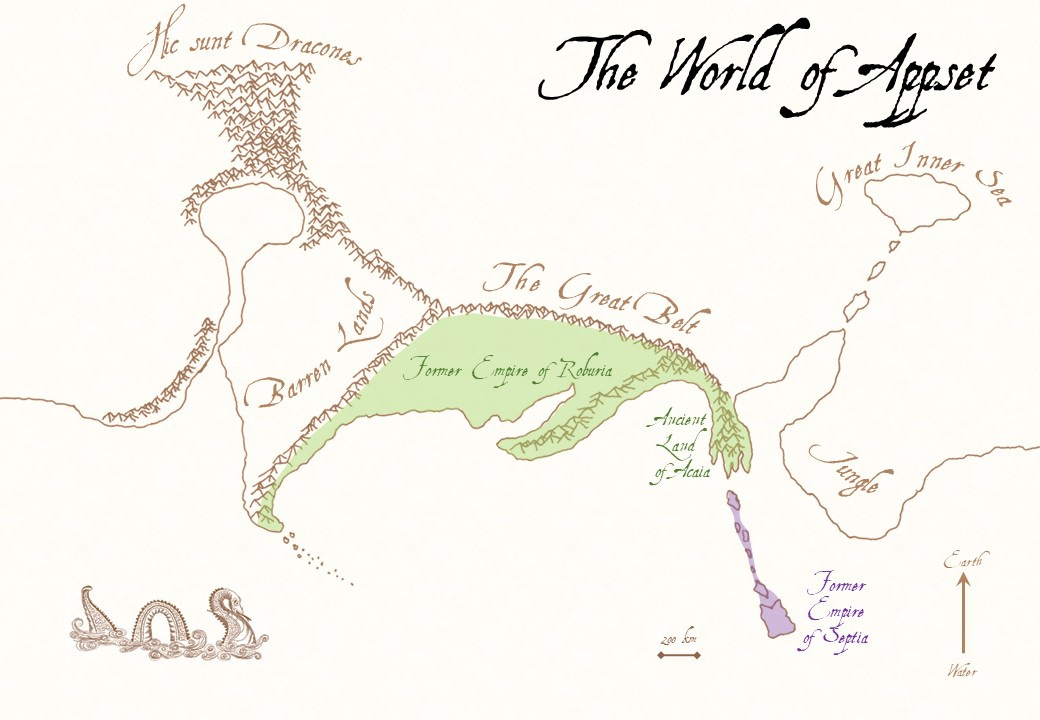The following timeline provides a general overview of key events that have occurred in the civilized lands of Appset. This should not be considered the full history of the setting but rather a sequence of milestones designed to give historical depth without focusing on underlying details.
The general premise is that the Appset calendar takes the foundation of Acaia as its reference point: this is canonically considered Year 0, from which the calendar begins. All years preceding this event are counted in reverse with the notation “BF” (“Before Foundation”), while years following Year 0 are noted as “AF” (“After Foundation”) or without any annotation. It is also important to highlight that the foundation of Acaia coincides with the election of Philodemos as the Patron of democracy and civilization. More precisely, ancient scholars believe that the foundation of Acaia was the act that allowed Philodemos to ascend as an Electus.
Regarding the timeline, a crucial detail is that all historical sources trace back only as far as 73 BF. The absence of any historical records before this year remains an inexplicable mystery; it is an objective fact that no information older than 73 BF exists. For this reason, this year is referred to as the “Veil of the World,” as no details are known about what happened before, nor are there any explanations for it.
73 BF – The Veil of the World: The starting point of recorded history in Appset. For unknown reasons, no information of any kind exists before this year.
24 BF – Philodemos begins the Palingenesis (palin - "again" - and genesis - "birth, creation" - means rebirth, renewal). The fifty-year period between 73 BF and the start of Palingenesis is known as the Dark Period due to the widespread chaos in the lands of the future empire of Roburia. Few sources exist from this era, and they all describe the lands within the Great Belt as plagued by wars and conflicts among populations. Due to the extreme fragmentation of territories and the constant turmoil, no notable events or figures are recorded.
0 – The Foundation of Acaia and the Ascension of Philodemos as Electus. The 25 years leading up to the foundation are known as the years of Palingenesis, during which Philodemos worked across a vast portion of lands to guide the peoples of Appset toward civilization and prosperity. Palingenesis will be described in detail when covering the life and works of Philodemos; for now, it suffices to say that it involved spreading ethical principles and moral values that were revolutionary for that time, leading an entire population to establish a nation based on these teachings. Philodemos primarily operated within the territory of The Hand of God and its neighboring regions (the area linking The Hand of God to the Spiked Talon). Through this, the local populations were able to organize under civil norms that allowed them to flourish as a society.
100 AF (approx) – The Beginning of Acaia’s Colonial Expansion. After about a century of prosperity and flourishing growth in social, cultural, and economic aspects, the people of Acaia begin to expand and establish colonies in nearby territories. This colonial expansion is a natural solution to accommodate the growing population beyond Acaia. The expansion is led by Auros, an Acaian figure who ascends as the Electus of economy and demography (whose story will be detailed later).
228 AF – One of Acaia’s colonies, founded on the Pre-Earth coast of the Spiked Talon, is the city of Robur. Due to its strategic location and trade relations with the various populations of the area, Robur quickly prospers. Within less than a century, the city becomes self-sufficient in resources, eventually declaring independence from Acaia. Historians consider this act the foundation of Roburia.
300 AF (approx) – The End of Acaia’s Colonial Expansion. This does not result from a single event but from a slow societal decline, leading to the cessation of expansion and the loss of many colonies. A significant sign of this decline occurs in 302 AF, when Acaia shifts from a democracy to a monarchy.
343 AF – While Acaia declines, Roburia expands, becoming the dominant nation of the Spiked Talon by annexing (voluntarily or otherwise) all the populations of the peninsula. Once the nation is consolidated, Roburia annexes Acaia after having conquered all of the Spiked Talon. This marks the first external annexation in what will become the future Roburian Empire.
662 AF – Following the annexation of Acaia, Roburia undergoes three centuries of expansion. Its peak is reached with the conquest of the Septia Islands, former Acaian colonies that had gained independence towards the end of the third century. At this point, the Roburian Empire controls all the lands (both mainland and islands) within the Great Belt, stretching from The Sting to The Hand of God.
738 AF – The Declaration of Independence and the Formation of the Septian Empire. With this event and the Act of Septia, the decline of Roburia begins, and Septia rises as the new dominant economic, military, and political power, positioning itself as Roburia’s main rival.
1088 AF – After a long period of fluctuating hostilities, Septia decisively defeats Roburia, bringing about the fall of the Roburian Empire. With Roburia’s collapse, Appset’s mainland enters an era of chaos, while Septia exerts hegemonic control from its islands.
1114 AF – Thanks to the efforts of Milonos, the Electus of defense and architecture (whose story will be detailed later), the last remaining military forces of Roburia regroup under the call of the League of the New Palingenesis. Despite being vastly outnumbered according to contemporary strategists, Milonos’ forces manage to decisively defeat Septia. This New Palingenesis allows the former Roburian Empire's lands to regain stability and prosperity under a new system, the legacy of Milonos, who ascends as Electus.
1350 AF – Your PCs roam the lands of Appset in search of adventure...






